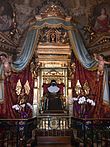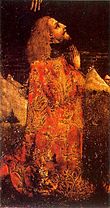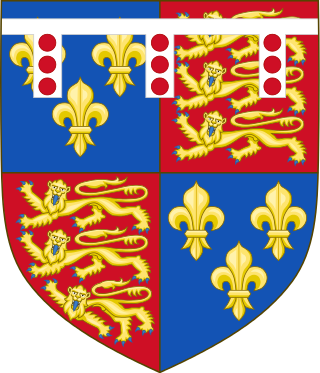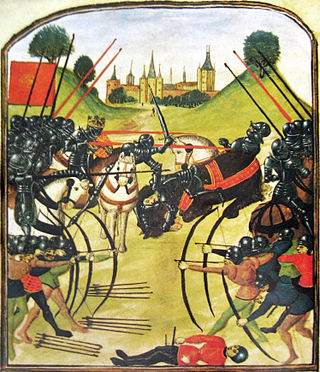Deaths
1460
- February 29 – Albert III, Duke of Bavaria-Munich (b. 1401)
- July 10
- Humphrey Stafford, 1st Duke of Buckingham, English military leader (b. 1402)
- John Talbot, 2nd Earl of Shrewsbury (b. c. 1413)
- Thomas Percy, 1st Baron Egremont, English baron (b. 1422)
- July 19 – Lord Scales, English commander (b. 1397)
- August 3 – King James II of Scotland (b. 1430) [44]
- September 20 – Gilles Binchois, Flemish composer (b. c. 1400)
- September 25 – Katharina of Hanau, German countess regent (b. 1408)
- November 13 – Prince Henry the Navigator, Portuguese patron of exploration (b. 1394)
- December 14 – Guarino da Verona, Italian humanist (b. 1370)
- December 30
- Edmund, Earl of Rutland, brother of Kings Edward IV of England and Richard III of England (b. 1443)
- Richard of York, 3rd Duke of York, claimant to the English throne (in battle) (b. 1411) [45]
- December 31 – Richard Neville, 5th Earl of Salisbury, English politician (executed) (b. 1400)
- date unknown
- Francesco II Acciaioli, last Duke of Athens (murdered by consent)
- Israel Isserlein, Austrian Jewish scholar (b. 1390)
- Reginald Pecock, deposed Welsh bishop and writer (b. c. 1392)
1461
- February 2 – Owen Tudor, Welsh founder of the Tudor dynasty (executed)
- March 28 – John Clifford, 9th Baron de Clifford (in battle)
- March 29
- April 8 – Georg von Peuerbach, Austrian astronomer (b. 1423)
- May 15 – Domenico Veneziano, Italian painter (b. c. 1410)
- July 22 – King Charles VII of France (b. 1403) [46]
- September 21 – Sophia of Halshany, queen consort of Poland (b. 1405)
- September 23 – Charles, Prince of Viana, King of Navarre (b. 1421)
- October 7 – Jean Poton de Xaintrailles, follower of Joan of Arc (b. c. 1390)
- November 6 – John de Mowbray, 3rd Duke of Norfolk (b. 1415)
- probable– Jonah, Metropolitan of Moscow
1462
- February 23 – Thomas Tuddenham, English landowner (b. 1401)
- February 26 – John de Vere, 12th Earl of Oxford (b. 1408) [47]
- February 27 – Władysław II of Płock, Polish noble (b. 1448)
- March 27 – Vasily II of Moscow, Grand Prince of Moscow (b. 1415)
- March 31 – Isidore II of Constantinople, Ecumenical Patriarch of Constantinople
- April 26 – William Percy, medieval Bishop of Carlisle (b. 1428)
- April 28 – Ulrich II. of Rosenberg, Czech noble and politic (b. January 13 1403)
- August 26 – Catherine Zaccaria, Despotess of the Morea
- September 17 – Anna of Saxony, Landgravine of Hesse, German royalty (b. 1420)
- November 11 – Anne of Cyprus, Italian noble (b. 1418)
- November 13 – Anne of Austria, Landgravine of Thuringia, consort of William III, Landgrave of Thuringia (b. 1432)
- November 25 – John Stourton, 1st Baron Stourton, English baron (b. 1400)
- date unknown
- King Esen Buqa II of Moghulistan
- Niccolò Gattilusio, last Prince of Lesbos
- Dài Jìn, Chinese painter (b. 1388)
1463




- March 9 – Catherine of Bologna, Italian Roman Catholic nun and saint (b. 1413) [48]
- May 25 – King Stephen Tomašević of Bosnia (beheaded)
- June 4 – Flavio Biondo, Italian humanist (b. 1392)
- June 17 – Infanta Catherine of Portugal, religious sister (b. 1436)
- September 23 – Giovanni di Cosimo de' Medici, Italian noble (b. 1421)
- November 1 – Emperor David of Trebizond (b. c. 1408)
- November 15 – Giovanni Antonio Del Balzo Orsini, Prince of Taranto and Constable of Naples (b. 1393)
- November 18 – John IV, Duke of Bavaria (b. 1437)
- November 29 – Marie of Anjou, queen of France, spouse of Charles VII of France (b. 1404) [49]
- December 2 – Albert VI, Archduke of Austria (b. 1418)
- December 16 – Sir Philip Courtenay, British noble (b. 1404)
- date unknown
- Jacob Gaón, Jewish Basque tax collector (beheaded by the mob)
- Ponhea Yat, last king of the Khmer Empire and first king of Cambodia (b. 1394)
1464
- January – Desiderio da Settignano, Italian sculptor (b. c. 1428 or 1430)
- February 23 – Zhengtong Emperor of China (b. 1427)
- March 8 – Catherine of Poděbrady, Hungarian queen consort (b. 1449)
- May 15 – Henry Beaufort, 3rd Duke of Somerset (executed) (b. 1436)
- May 17 – Thomas de Ros, 9th Baron de Ros, English politician (executed) (b. 1427)
- May 25 – Charles I, Count of Nevers (b. 1414)
- June 18 – Rogier van der Weyden, Flemish painter (b. 1399 or 1400)
- August 1 – Cosimo de' Medici, ruler of Florence (b. 1389)
- August 11 – Nicholas of Cusa, German mathematician and astronomer (b. 1401)
- August 12 – John Capgrave, English historian and theologian (b. 1393)
- August 14 – Pope Pius II (b. 1405) [13]
- September 7 – Otto III, Duke of Pomerania-Stettin (1460–1464) (b. 1444)
- September 23 – Bernardo Rossellino, Italian sculptor and architect (b. 1409)
- September 26 – Benedetto Accolti the Elder, Italian jurist and historian (b. 1415)
- November 16 – John, Margrave of Brandenburg-Kulmbach (b. 1406)
- November 23 – Blessed Margaret of Savoy (b. 1382 or 1390)
- December 2 – Blanche II of Navarre (b. 1424)
- date unknown– Fra Mauro, Venetian Camaldolese monk, cartographer and accountant (b. c. 1400)
1465
- January 5 – Charles, Duke of Orléans, French poet (b. 1394) [50]
- January 14 – Thomas Beckington, English statesman and prelate
- January 29 – Louis, Duke of Savoy (b. 1413)
- March 30 – Isabella of Clermont, queen consort of Naples (b. c. 1424)
- April 30 – Jacob of Juterbogk, German theologian (b. c. 1381)
- May 12 – Thomas Palaiologos, claimant to Byzantine throne (b. 1409) [51]
- August 11 – Kettil Karlsson, regent of Sweden and Bishop of Linköping (plague; b. 1433)
- August 14 – Abd al-Haqq II, last Marinid Sultan of Morocco (b.1419)
- September 25 – Isabella of Bourbon, countess consort of Charolais, spouse of Charles the Bold (b. c. 1434)
- November 20 – Malatesta Novello, Italian condottiero (b. 1418)
- date unknown– John Hardyng, English chronicler (b. 1378)
1466
- February 23 – Girishawardhana Dyah Suryawikrama, 9th Maharaja of Majapahit
- March 6 – Alvise Loredan, Venetian admiral and statesman (b. 1393)
- March 8 – Francesco I Sforza, Duke of Milan (b. 1401) [52]
- August – Hacı I Giray, first ruler of the Crimean Khanate (b. 1397)
- October 30 – Johann Fust, German printer (b. c. 1400)
- December 13 – Donatello, Italian artist (b. 1386) [53]
- Date unknown
- Barbara Manfredi, Italian noblewoman (b. 1444)
- Isotta Nogarola, Italian writer and intellectual (b. 1418) [54]
- Nicolaus Zacharie, Italian composer (b. c. 1400)
1467
- March 13 – Vettore Cappello, Venetian statesman
- March 29 – Matthew Palaiologos Asen, Byzantine aristocrat and official
- April 20 – Dorotea Gonzaga, Italian noble (b. 1449)
- April 30 – John, Count of Angoulême (b. 1399)
- June 15 – Philip III, Duke of Burgundy (b. 1396)
- September 3 – Eleanor of Portugal, Holy Roman Empress (b. 1434)
- December 12 – Jošt of Rožmberk, Bishop of Breslau, Grand Prior of the Order of St. John (b. 1430)
- December 15 – Jöns Bengtsson Oxenstierna, archbishop and Regent of Sweden (b. 1417)
- date unknown
- Maria of Tver, Grand Princess consort of Muscovy, spouse of Ivan III of Russia (b. 1447)
- Peter III Aaron, prince of Moldavia
- Jahan Shah, leader of Turkmen
- Khan Xälil of Kazan
1468

- February 3 – Johannes Gutenberg, inventor of printing press with replaceable letters (b. c.1398) [55]
- March 12 – Astorre II Manfredi, Italian noble (b. 1412)
- September 23 – Sejo of Joseon, King of Joseon (b. 1417)
- June 10 – Idris Imad al-Din, supreme leader of Tayyibi Isma'ilism, scholar and historian (b. 1392) [56]
- June 14 – Margaret Beauchamp, countess of Shrewsbury
- June 30 – Lady Eleanor Talbot, English noblewoman
- July 5 – Alfonso, Prince of Asturias (b. 1453)
- September 26 – Juan de Torquemada, Spanish Catholic cardinal (b. 1388) [57]
- October 7 – Sigismondo Pandolfo Malatesta, lord of Rimini (b. 1417)
- October 28 – Bianca Maria Visconti, Duchess of Milan (b. 1425)
- November 24 – Jean de Dunois, French soldier (b. 1402)
- December 6 – Zanobi Strozzi, Italian painter (b. 1412)
- date unknown
- Joanot Martorell, Spanish writer (b. 1419) [58]
- Francesco Squarcione, Italian artist (b. ca. 1395)
- Zara Yaqob, Emperor of Ethiopia (b. 1399)
- Pomellina Fregoso, Monegaque regent (b. 1388
1469
- May 30 – Lope de Barrientos, powerful Castilian bishop and statesman (b. 1382)
- August 12 – Richard Woodville, 1st Earl Rivers (executed) (b. 1405)
- September 25 – Margaret of Brittany, Breton duchess consort (b. 1443)
- October 8/10 – Filippo Lippi, Italian artist (b. 1406) [59]
- December 2 – Piero di Cosimo de' Medici, ruler of Florence (b. 1416)
- December 31 – King Yejong of Joseon (b. 1450)
- date unknown
- Abu Sa'id Mirza, ruler of Persia and Afghanistan (b. 1424)
- Niccolò Da Conti, Italian merchant and explorer (b. 1395)
- Andrew Gray, 1st Lord Gray (b. c. 1390)
- Moctezuma I, Aztec ruler of Tenochtitlan, son of Huitzilihuitl (b. 1390) [60]





